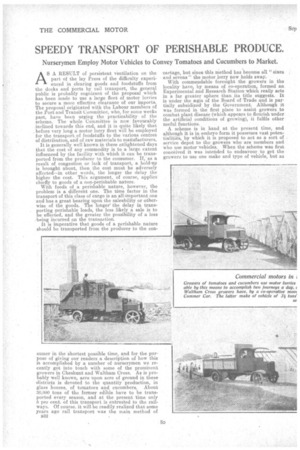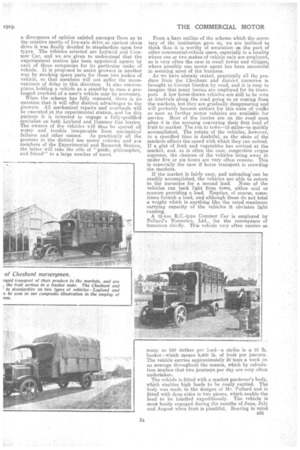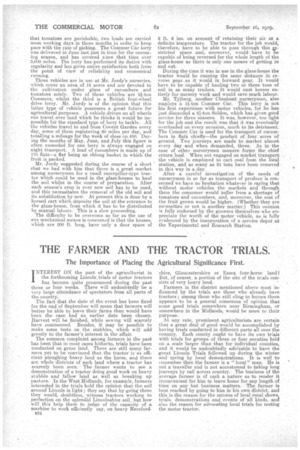SPEEDY TRANSPORT OF PERISHABLE PRODUCE.
Page 10

Page 11

Page 12

If you've noticed an error in this article please click here to report it so we can fix it.
Nurserymen Employ Motor Vehicles to Convey Tomatoes and Cucumbers to Market.
AS A RESULT of persistent ventilation on the part of the lay Press of the difficulty experienced in _clearing goods and foodstuffs from the docks and ports by rail transport, the general public is probably cognizant of the proposal which has been made to use a large fleet of motor lorries to secure a more effective clearance of our imports. The proposal originated with the Labour members of the Port and Transit Conimittee, who, for some weeks past, have been urging the practicability of the scheme.. The whole Committee is now favourably inclined towards this end, and it is quite likely that before very long a motor lorry fleet will be employed for the transport_of foodstuffs to the various centres of distribution, and of raw materials to manufacturers. It is generally well known in these enlightened days that the cast of any commodity is to a large extent influenced by the facility with which it can be transported from the producer to the consumer. If,as a result of congestion or lack of transport, a hold-up is brought about, then the cost must be adversely affected—in other words, the longer the delay the higher the cost. This argument, of course, applies chiefly to goods of a non-perishable nature.
With foods of a perishable nature, however, the problem is a different one. The time factor in the transport of this class of cargo is an all-important one and has a great bearing upon the saleability or otherwise of the goods. The longer the delay in transporting perishable loads, the less likely a sale is to be effected, and the greater the possibility of a loss -being incurred •on the transaction.
It is imperative that goods of a perishable nature should be transported from the producer to the con
sumer in the shortest possible time, and for the purpose of giving our readers a description of how, this is accomplished by a number of nurserymen we recently got into touch with some of the prominent growers in Cheshunt and Waltham Cross. As is probably well known, acre upon acre of ground in these districts is devoted to the quantity production, in glass houses, of tomatoes and cucumbers. About 30,000 tons of the former edible have to be transported every season, and at the present time only 5 per cent. of this transport is entrusted to the railways. Of course, it will be readily realized that some years ago rail transport was the main method of B32 'cartage, but since this method has become all "sixes and sevens" the motor lorry now holds sway.
With commendable foresight the growers in the locality have, by means of co-operation, formed an Experimental and Research Station which really acts in a far greater sphere than its title suggests. It is under the zegis of the Board of Trade and is partially subsidized by the Government. Although it was formed in the firstplace to assist growers to combat plant disease (which appears to flourish under the artificial conditions of growing), it fulfils other useful functions.
A scheme is in hand at the present time, and although it is in embryo form it possesses vast potentialities, by which it is proposed to act as a sort of . service depot to the growers who are members and who use motor vehicles. When the scheme was first conceived it was intended to endeavour to get the growers to use one make and type of vehicle, but as a divergence of opinion existed amongst them as to the relative merits of live-axle drive as against chain drive it was finally decided to standardize upon two types. The vehicles selected are Leyland and Commer Car, and we are given to understand that the experimental station has been appointed agents by each of these companies for its particular make of vehicle. It is proposed to assist growers in another way by stocking spare parts for these two makes of vehicle, so that members will not suffer the inconvenience of delay in this direction. It also contemplates holding a vehicle as a stand-by in case a prolonged overhaul of a user's vehicle may be necessary. When the scheme has fully matured, there is no question that it will offer distinct advantages to the growers. All mechanical repairs and overhauls will be executed at the experimental station, and for this purpose it is intended to engage a fully-qualified specialist on both Leyland and Commer Car lorries. The owners of the vehicles will thus be spared all worry and trouble inseparable from niechanical failures and other causes. As practically all the growers in the district use motor vehicles and are members of the Experimental and Research Station, the latter will take the role of "guide, philosopher, and friend" to a large number of users. From a bare outline of the scheme which the secretary of the institution gave us we are inclined to think that it is worthy of emufation co the part of other commercial-vehicle users, especially in a locality where one or two makes of vehicle only are employed, as is very often the case in small towns and villages, where possibly one motor agent has been successful in securing most of the business. As we have already stated, practically all the produce from the Cheshunt and district nurseries is brought to Covent Garden by road, and it is easy to imagine that many lorries are employed for its transport. A few horse-drawn vehicles are still to be seen at intei-vals along the road going to or coming from the markets, but they are gradually disappearing and will probably become extinct for this class of traffic
so soon as further motor vehicles are available for service. Most of the lorries are on the road soon after 6 in the morning conveying their first load of.
fruit to market. The run to town—I5 miles—is quickly accomplished. The return of the vehicles, however, to a specified time is doubtful, as the state of the markets affects the speed with which they can Upload. If a glut of fruit and vegetables has arrived at the market, and, as is often the case, congestion reigns supreme, the chances of the vehicles being away in under five or six hours are very often remote. This is especially the ease if horse transport is crowding the markets.
If the market is fairly easy, and unloading' can be readily accomplished, the vehicles are able to return to the nurseries for a second• load. None of the
vehicles run back light from town, either coal or manure providing a load. -Empties, of course, some
times furnish a load, and although these do not total a, weight which is anything like the rated maximum carrying capacity of the vehicles it obviates light running. A 3A-ton R.C.-type Commer Car is employed by Pollard's Nurseries, Ltd., for the conveyance of tomatoes chiefly. This vehicle very often carries as
Many as 550 strikes per load—a strike is a 12 lb. hasket—which means 6,600 lb. of fruit per. journey. The vehicle carries approximately 30 tons a, week on • an average throughout the season, which by calculation implies that two journeys per day are very often undertaken.
The vehicle is fitted with a, market gardener's body, which enables high loads to be easily carried. The body was made to the designs of Mr. Pollard and is fitted with drop sides in two pieces, which enable the load to be bandied expeditiously. The vehicle is most busily engaged during the months of June, July and August when fruit is plentiful. Bearing in mind. that tomatoes are perishable, two loads are carried most working days in these months in order to keep pace with the rate of picking. The Commer Car lorry was delivered in June last just in time for the orteornnig season, and has covered since that time over 3,000 miles. The lorry has performed its dutieS with regularity and has given entire satisfaction both from the point of view of reliability and. economical running.
Three vehicles are in use at Mr. Jordy's nurseries, which cover an area of 15 acres and are devoted to the cultivation under glass of cucumbers and tomatoes solely. Two of these vehicles are 34-ton Commers, whilst, the third is a British. four-wheel drive lorry. Mr. Jordy is of the opinion that this latter type of vehicle possesses a great future for agricultural purposes. A vehicle driven on all wheels can travel over land which he thinks it would be impossible for the standard type of lorry to tackle. All the vehicles travel to and from Covent Garden every clay, some of them registering 60 miles per day, and totalling a mileage far the week of close on 400. During the months of May, June, and July this figure is often exceeded for one lorry is always engaged on night transport. A load of cucumbers is made up of 170 flats—a, flat being an oblong basket in which the fruit is packed.
Mr. Jordy suggested during the course of a short chat we had with him that there is a great market among nurserymen for a small caterpillar-type tractor which could be used in the glass-houses to haul the soil whilst in the course of preparation. After each season's crop is over new soil has to be used, and this necessitates the removal of the old soil and its substitution by new. At present this is done by a horsed cart which deposits the soil at the entrance to the glass-house, from which it has to be distributed by manual labour. This is a slow proceeding. The difficulty to be overcome so far as the use of any mechanical means is concerned is that the houses, which are 200 ft. long, have only a door space of
2 ft. 6 ins, on account of retaining their air at a definite temperature. The tractor for the job would, therefore, have to be able to pass through this Lestricted space and, moreover, would have to be capableof being reversed for the whole length of the glass-house as there is only one means of getting in and out.
During the time it was in use-in the glass-house the tractor would be running the same distance in reverse gear as it would in forward gear. It would have to be capable of hauling two or three tons of soil in as many trailers. It would oust horses entirely for nursery work and would save much labour.
Mr. Tyjberg, another Cheshunt nurseryman, also employs a 34-ten Commer Car. This lorry is not his first experience with motor vehicles, for he has just discarded a 21-2-ton Selden, which has given good service for three seasons. It was, however, too light for the job and the result was that it was eventually overloaded on every occasion, much to its detriment. The Commer Car is used for the transport of cucumbers in flats chiefly—the product of four acres of ground. Two journeys are made to market almost every day and when demanded, three. As in the case of other nurserymen manure ,forms the chief "return load. When not engaged on market transport the vehicle is employed to cart coal from the Wal station, and as many as 24 tons have been removed in. this way in a day.
After a careful investigation of -the needs of nurserymen in so far as transport of produce is concerned we have no hesitation whatever in saying that without motor vehicles the markets and through there the consumer would suffer from a shortage of tomatoes and cucumbers, and, moreover, the cost of the fruit grown would be higher. (Whether they are necessities or not is another matter.) This ooinion is fully endorsed by the growers themselves who appreciate the worth of the motor vehicle, as is fully evidenced by the inauguration of a service depot at the Experimental and Research Station.
























